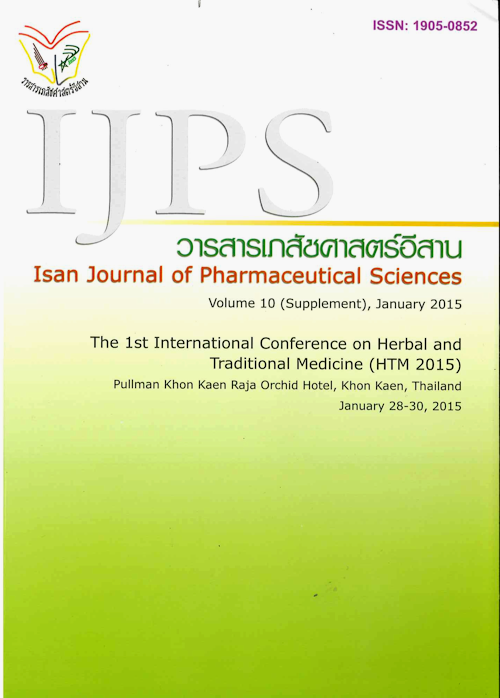Preparation of α-mangostin Rich Extract using Green Extraction Concept
Main Article Content
Abstract
of bioactive compounds present in GPE is the prenylated xanthones, particularly α-mangostin, which has been used as a standard marker for a quality control method for GPE (Nualkaew et al., 2012). Nowadays, GPE has been used in several commercial dietary supplements, cosmetics and herbal medicines (Pothitirat et al., 2009). Moreover, a preparation of GPE has been approved in the Thai
national list of essential medicines (2013) for wound healing purposes. The Thai national list of essential medicines has described the preparation of GPE as a solution containing 10% w/v of a (95%) ethanol extract from G. mangostana dried pericarp. However, a standard concentration of the active ingredient in the solution, particularly the α-mangostin content was not established. Thus, the quality of any GPE preparations may vary from batch to batch due to the different contents of α-mangostin. This may affect their effi cacy for treatments. Standardization of α-mangostin content in GPE or GPE preparation should be a good way to guarantee a good therapeutic effi cacy. Extraction is an important process for the preparation of medically useful extracts that contain an optimum level of active constituents. An appropriate extraction method as well as a suitable solvent for extraction is the fi rst requirement for producing an appropriate yield of active constituents in the
extracts. There have been some reports on obtaining preparations of GPE that have increased amounts
of α-mangostin, for example, an extraction of the pericarps with (95%) ethanol using the Soxhlet apparatus
produced the highest yield of an extract (26.60% dry weight) and the highest content of α-mangostin (13.51% w/w of crude extract). This yield was much higher than when other extraction methods were used, such as maceration, percolation, ultrasonic extraction and extraction using a
magnetic stirrer, and the use of other extraction solvents (70% and 50% ethanol). Recently, the same
research group reported that dichloromethane was the most suitable solvent for extraction of α-mangostin from G. mangostana pericarps, and yielded an -mangostin content of up to 46.2% w/w (Pothitirat et al., 2010). However, the use of dichloromethane, a halogenated hydrocarbon, as a solvent
for extraction may be harmful due to its toxicity including the possibility of the onset of dizziness, headache, nausea, irritation or intense burning in the skin, eyes and respiratory tract. There are also reports that dichloromethane can induce pancreatic, liver, biliary passages, breast and brain cancers (Ames et al., 2000). Moreover, dichloromethane is expensive and must be completely removed by evaporation before use. Obviously this results in an increased cost for producing the product. Recent trends in extraction techniques have largely focused on fi nding solutions that could minimize the use of potentially toxic solvents. This must be achieved while also enabling process intensifi cation and a cost-effective production of a high quality extract. We are therefore interested in the preparation of the
α-mangostin extracts from G. mangostana pericarps using ‘green extraction concepts’. A ‘green extraction concept’ is based on the design of extraction procedures that can reduce energy consum ption, allows the use of alternative safe solvents and renewable natural products, and ensures a safe and high quality extract (Chemat et al., 2012).
The present studies have focused on investigating some topical formulation excipients, inclu ding isopropyl myristate, propylene glycol, mineral oil, cetyl alcohol and stearyl alcohol, as alternative green solvents for extraction of α-mangostin from G. mangostana pericarps using microwave assisted extraction (MAE), a green extraction method. These solvents have similar polarities to dichloromethane,
but they are considered to be safer and cheaper. In addition, the obtained extract can be used directly for formulation of GPE preparations without any steps that require solvent evaporation, and have thus, result in a reduced cost of production.
Article Details
In the case that some parts are used by others The author must Confirm that obtaining permission to use some of the original authors. And must attach evidence That the permission has been included
References
Ames, R., Brown, J. and Wang, Y. 2000. Dichlo-romethane in drinking water. Office of Environmental Health Hazard Assess-ment.
Chairungsrilerd, N., Takeuchi, K., Ohizumi, Y., Nozoe, S. and Ohta, T. 1996. Mangosta-nol, a prenyl xanthone from Garcinia mangostana. Phytochemistry. 43: 1099-1102.
Chemat F., Vian, M.A. and Cravotto, G. 2012. Green extraction of natural products: Concept and principles. International Journal of Molecular Sciences. 13: 8615-8627.
Chomnawang, M.T., Sakagami, S.S., Nukoolkarn, V.S. and Gritsanapan, W. 2005. Antimi-crobial effects of Thai medicinal plants against acne-inducing bacteria. Journal of Ethnopharmacology. 101: 330-333.
Gutierrez-Orozco, F. and Failla, M.L. 2013. Bio-logical activities and bioavailability of mangosteen xanthones: a critical review of the current evidence. Nutrients. 5: 3163-3183.
Ibrahim, M.Y., Mariod, A.A., Mohan, S., Hashim, N.M., Abdulla, M.A., Abdelwahab, S.I., Arbab, I.A. and Ali, L.Z. 2014. α-Mangostin from Garcinia mangostanaLinn: an updated review of its pharma-cological properties. Arabian Journal of Chemistry. 1-39.
Nganlasom, J., Suttitum, T., Jirakulsomchok, D. and Puapairoj, A. 2008. Effects of Cen-tella asiatica Linn. leaves and Garcinia mangostana Linn. hull on the healing of dermal wounds in diabetic rats. Srinagar-ind Medical Journal. 23: 402-407.
Nualkaew, N., Morita, H., Shimokawa, Y., Kinjo, K., Kushiro, T., De-Eknamkul, W., Ebi-zuka, Y. and Abe, I. 2012. Benzophe-none synthase from Garcinia mangos-tana L. pericarps. Phytochemistry. 77: 60-69.
Pothitirat, W., Chomnawang, M.T. and Gritsana-pan, W. 2009. Anti-acne inducing bacte-ria activity and α-mangostin content of Garcinia mangostana fruit rind extracts from different provenience. Songklana-karin Journal of Science and Technology. 31: 41-47.
Pothitirat, W., Chomnawang, M.T., Supabphol, R. and Gritsanapan, W. 2010. Free radical scavenging and anti-acne activities of mangosteen fruit rind extracts prepared by different extraction methods. Pharma-ceutical Biology. 48: 182-186.


